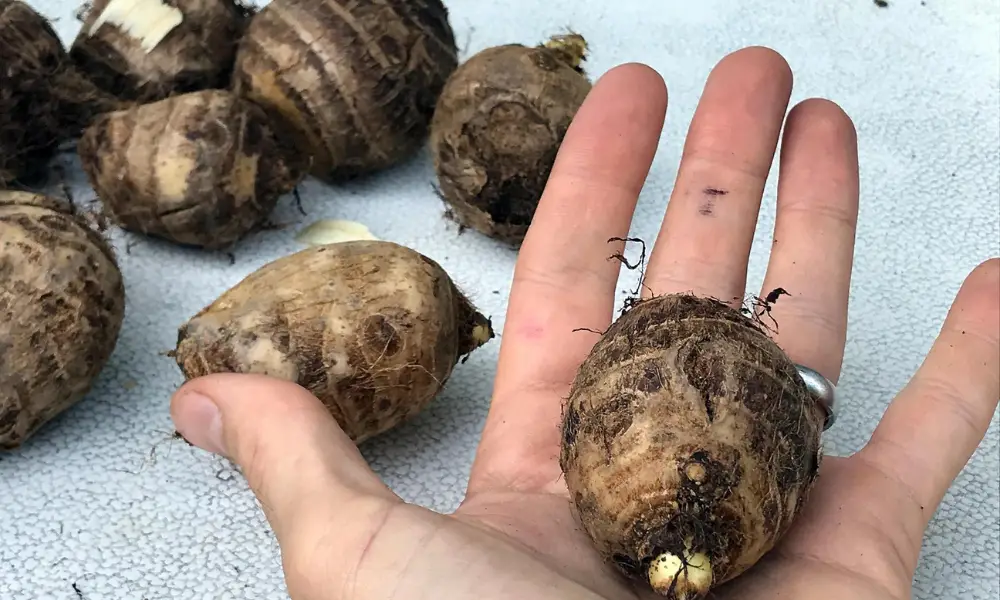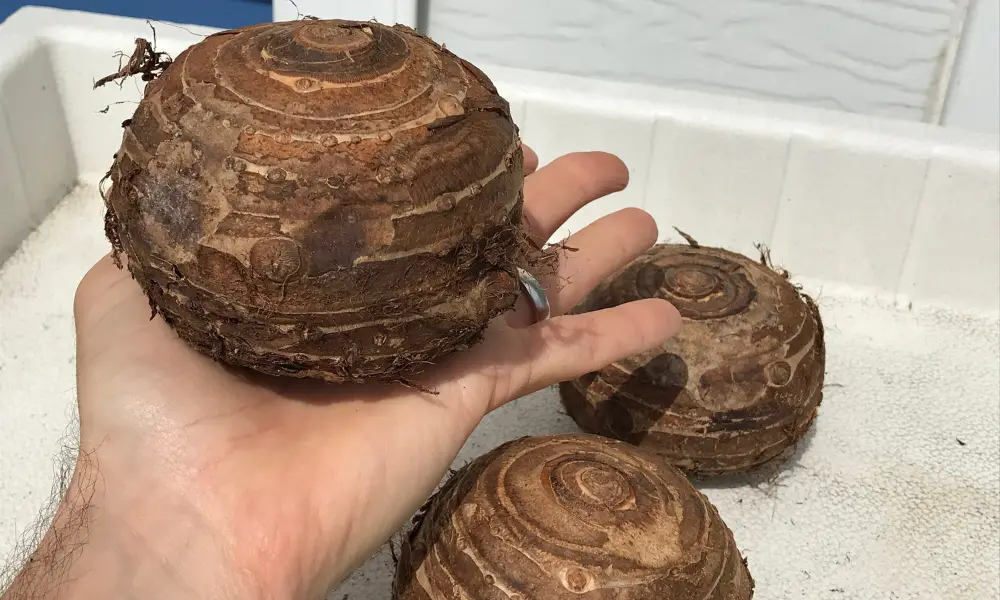Adding elephant ear plants to your garden can be entertaining and dramatic, but just because these lovely plants are not cold-hardy does not mean you couldn’t store elephant ear bulbs for use in subsequent years. Preserving plants or elephant ear bulbs for the winter can help you save money.
If you want to keep your Elephant Ear bulb healthy, you’ll need to clean it. This tropical plant is prone to insect and fungus damage. If you catch the problem early, it can be treated. You can also save the bulb for next year. This easy-to-grow plant can be grown indoors or in a raised bed, but it needs to be kept warm and moist. You can plant it outside in the spring when it warms up enough. Then, move it inside during the colder months.

What is Elephant Ear?
A genus of tropical perennial plants known for their huge, heart-shaped leaves goes by the common name “elephant ears.” Although there are others with a similar appearance and growth pattern, most of these herbaceous plants in the arum or aroid family (Araceae) sold as ornamentals belong to the genera Colocasia, Alocasia, and Xanthosoma.
While Xanthosoma is endemic to tropical America, the first two genera are native to tropical southern Asia, Indonesia, Malaysia, New Guinea, sections of Australia, or the Pacific Islands. In tropical areas, several species are grown for their edible starchy corms or tubers, which serve as a significant staple food.
How to Store Elephant Ear Bulbs?
Digging the bulbs out of the ground is the first step in storing elephant ear bulbs. If the elephant ear bulb is damaged, it could rot over the winter. Elephant ear bulbs must be dug out of the ground intact if you want to save them successfully for the winter.
It is a good idea to start digging about a foot (31 cm) away from the base of the plant and gently lift the plant and bulb to preserve the bulb. The elephant ear bulbs need to be cleaned next to save the elephant ears. Do not scrape them; you can give them a gentle rinse. Any remaining dirt is acceptable on the bulb. You can also cut off any remaining foliage at this time.
The elephant ear bulbs must be dried after being cleaned. Elephant ear bulbs should be kept in the dark, warm area for about a week. For the bulbs to dry properly, ensure the area has excellent air circulation. Following this, store elephant ear bulbs in a dry, cool environment while being wrapped in paper.
While they are in storage every few weeks, check on the elephant ear bulbs to ensure no bugs or decay. The insecticide should be applied to the bulbs if pests are discovered. To prevent the rot from spreading to the other bulbs, throw away the damaged elephant ear bulb if you locate it.
How to Plant Elephant Ear Bulbs?
No matter what kind you choose for your yard, all elephant ears are grown similarly. For healthy growth, they all need the same climatic conditions.
The Ideal Time to Plant
The first advice is to wait to plant your elephant ears until there is no longer a chance of frost.
Remember that because they are tropical plants, they require temperatures above 55°F at night and 70°F or higher during the day. There is little possibility that your elephant ear will flourish once the temperature falls below 50°F.
Therefore, plant the tubers in the spring when the soil is constantly warm, and the weather is warm outside.
Instead, you may plant the bulbs in a pot and grow them inside in a warm, sunny place to get a head start on producing this addition to your garden. You can relocate the plant outside once the weather is nice.
Growing Conditions of Choice
Despite the fact that elephant ears are thought to require little maintenance, choosing a site that satisfies all of their requirements will result in optimum development.
Location of the Scene and Lighting
Grow elephant ears in a protected area that is not exposed to strong winds if you want to maintain the showy foliage’s best appearance. The leaves could shred if there is constant wind.
Elephant Ears Thrive in Either Full Sun or Light Shade
Choose a location that offers some afternoon shade or filtered sunlight if you live in a hot region. A sunny environment will guarantee that the hue of your variety’s darker-colored foliage stays deep and bright.
How to Take Care of Elephant Ear Bulbs?
Elephant ear bulbs must be kept moist after planting, so keep the soil around them humid. When the top inch of the soil feels dry, water bulbs are grown in pots. adding a layer of mulch to the area may help the soil retain moisture.
For optimal development, apply liquid fertilizer frequently (every three to four weeks).
Elephant ears require special care since the bulbs are susceptible to damage from freezing temperatures. Before it gets colder than 40°F (4.5°C), take this action. If you live in an area with harsh winters, grow elephant ears as annuals or dig up the bulbs and store them for replanting the following year.
As Brody Hall advises, “take care not to cut or nick the tubers using digging equipment as any injury will cause a bulb to not sprout the following season.” “Once the bulbs are pulled up, keep them in some moist coconut coir or potting soil in a supermarket bag and set them in a dark, cool area of the house,” the instructions state.
Which End Goes Down on Elephant Ear Bulbs?
Examine closely to determine which end of the elephant ear bulb is downward. According to Brody Hall, “sometimes it’s fairly visible,” as there will be an old stalk or a newly emerging stalk projecting from the top of the bulb.
However, in other cases, gardeners need to look for small to medium-sized nodules on the bulb’s base. When planting, these should be facing downward and toward the earth because they are the first signs of roots.
What are the Different Types of Elephant Ear Bulbs?
Elephant ear bulb varieties Plants with enormous foliage resembling the ear of a pachyderm are known as elephant ears. Elephant ear plant varieties thrive in various soil conditions, including rich, wet soil, partial shade to full sun, and range in size from enormous plants nearly 10 feet (3 meters) tall to little 2-foot (0.5 m) tall species. White spathes and spadix flower types are produced by several.
Elephant ears refer to four different plant species: Colocasia, Caladium, Alocasia, and Xanthosoma.
Colocasia
There are 200 species of colocasia, which is native to swampy regions of Asia. It is the original variety of elephant ear plants. The maximum size of a leaf is 3 feet (1 m) long and 2 feet (0.5 m) broad. The heart-shaped leaves can reach 8 feet (2.5 meters) on long, rigid petioles.
Caladium
The ubiquitous elephant ear plant found in nurseries is known as a caladium. These perennial foliage plants can withstand cold temperatures as low as USDA zone 8. The leaf of this much smaller elephant ear species measures 8 to 12 inches (20-30.5 cm) in length and only grows to a height of 2 feet (0.5 m).
Alocasia
Alocasia grows into 6-foot (2-meter) tall plants with arrow-shaped foliage and blooms that resemble calla lilies.
Xanthosoma
Temperatures above 68 degrees Fahrenheit are required for Xanthosoma (20 C.). The arrow-shaped blades usually contain ornamental veins. It is uncommon to cultivate Xanthosoma.
What is the Common Issue Associated with Elephant Ear?
Elephant ears are quick-growing, simple to grow, and often trouble-free. However, since they enjoy being near water, fungus diseases pose the greatest risk to them. 3
Leaves Begin to Yellow
Yellowing leaves could indicate a need for more or less sunlight, water, or fertilizer. As an alternative, the plant can hibernate for the season. Trim the yellow leaves, then wait until the following spring to see them reappear.
Low-Hanging Leaves
If the light, water, or fertilizer levels are off, elephant ears will droop. Large leaves can also droop if they grow too heavy, although this can be avoided by supporting the plants with stakes. Inappropriately cold temperatures will also cause plants to wither.
Pale Leaves or Stunted Leaves
Deformed, smaller, or pale leaves frequently indicate that your plant requires more food, light, or water. You can move your plant, give it additional water, or fertilize it.
Wilting
Wilting is a symptom of the plant not getting enough water and being exposed to excessive heat and sunlight. Move your plant to a shaded location and prepare to water it more frequently.
Conclusion
When it comes to elephant ear bulbs, they need to be properly cared for to survive the cold months of winter. The tubers need to be protected, stored, and dried. They can also be moved inside for the season and brought out once the weather worsens.
The first step in keeping elephant ear bulbs alive is ensuring you get the proper amount of water for them. You do not want to overwater the plant to prevent mold growth. You should only water the bulb once the top inch of soil is dry. Elephant ear bulbs can be stored in the garage or a root cellar. They should be kept in a cool, dark place with good air circulation. They can also be dried out and wrapped in paper for storage.
